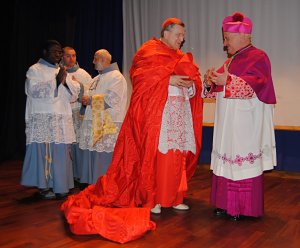Blog
Now is the time for lay leadership
20 December 2012
From the Catholics for Ministry Web Site

These men are not models but a real cardinal and archbishop
You might have expected that Benedict XVI and the prelates of the Vatican would have been pro-active in confronting the issue of child sexual abuse and reaching out sympathetically to assist and support Australian Catholics in confronting it. But they weren’t.
They were obsessed with their own issues. On 19 November the papal Secretary of State, Tarcisio Cardinal Bertone, issued a memo that prohibited clergy from wearing secular dress and imposed the wearing of the cassock. He particularly pointed out that the cassock was obligatory for Cardinals and Bishops working the Vatican during office hours and that the cassock or clerical dress was also obligatory for priests. Religious must wear their habit always. Bishops visiting Rome must always wear the cassock. The world synod on the so-called ‘new evangelization’ had concluded just a few weeks earlier in Rome when bishops and experts debated how the church might spread the message of Jesus. Clearly Cardinal Bertone, speaking for Benedict XVI, thought that wearing the cassock was very ‘important’ for both evangelization and Australian Catholics! One wonders what Jesus, the man who according to the Gospels ‘had nowhere to lay his head’, would make of this kind of (very expensive) ecclesiastical dress-ups?
Preoccupation with clerical dress is a symptom of the very thing – clericalism and a closed in-group mentality - that created the problems that the Australian Church now faces especially in the light of the forthcoming Royal Commission. The papacy and the Vatican have become so self-engrossed that they are already in a kind of practical ‘schism’, by which I mean they are cut-off from the reality of the rest of the Church as they retreat into an absurd dressed-up world of their own creation. They imagine that all truth and wisdom is revealed to them and through them – increasingly in practice senior Vatican staff see themselves as sharing in papal infallibility – and they see the rest of the Church community as merely the passive recipients of their pronouncements.
Over the last 150 years, and especially during the last two papacies, a whole new phenomenon in church history has emerged: a kind of omnipotent and omnipresent papacy whereby the pope is seen as the ‘bishop of the world’ with local bishops as mere branch managers of head office. Under John Paul II (1978-2005) and Benedict XVI (2005-) an absolutist, monarchical papacy is increasingly taking on the lineaments of a multinational corporation. All authority is centred at the top and descends from above. Absolute loyalty to the priorities and policies of head office are the desired hallmarks of regional branch managers (bishops) and local managers (priests) with the Catholic community as passive consumers. Regional managers now answer almost exclusively to head office; the traditional sense that their primary responsibility is to their dioceses has been almost entirely lost.
Such a structure is the complete antithesis of what was intended by the Constitution on the Church (Lumen gentium) of Vatican II. The primacy of the local community has been swallowed-up by a centralized structure that is unique in church history. Never before has the Church been so centralized. Accountability to the Catholic community is absolutely foreign to a structure of this nature. Given the dominance of a patriarchical Italianate-Latin mentality in the higher echelons of the hierarchy it is understandable that there is no sense of accountability of the leadership to the community.
Significantly there is no real word in Italian for the English word ‘accountability’. Italian dictionaries will translate ‘accountability’ as responsibilita which translates as ‘responsibility’ in English and principally refers to obligation of the subject rather than an emphasis on leaders answering to the stakeholder community as to how the Church is administered. The leadership answers only to God Who can be remarkably silent and absent when leaders’ own biases and fancies come into play.
Catholicism, unlike the Orthodox, Anglican and Protestant Churches, has no structure whatsoever that resembles the synods that gather together bishops, clergy and laity to discern the call of God and the leadings of the Holy Spirit. The contemporary Catholic Church is the absolute antithesis of the church in the New Testament and the first centuries of church history which remain normative for all subsequent developments. Popes like Leo I the Great (440-461) and Gregory I the Great (590-604) would consider the present government structures of Catholicism, including the papacy, to be so out of kilter with what they understood of the nature of the church as to be heretical. Many medieval theologians would have shared this view.
It is difficult to see ourselves as Catholics in historical perspective because we tend to assume that what we experience now as the norm. But the reality is the church at present is so centralised and out of balance as to be completely beyond traditional norms, let alone the norms of Jesus. As the great reformer Martin Luther said crux probat omnia – ‘the cross is the test of everything’.
The forthcoming Royal Commission provides Australian Catholics with a unique opportunity to demand that the Australian bishops begin the process of returning to the mainstream of historical Catholicism where there is a balance between all of the elements that go to make-up the Catholic community. The voice of the laity has to be heard and accountability has to be demanded from hierarchs. The Royal Commission can’t do this for us; only we can achieve that. But it does give us an opportunity and, given the complete failure of the bishops, it is the laity that must show leadership.
Care to comment? .